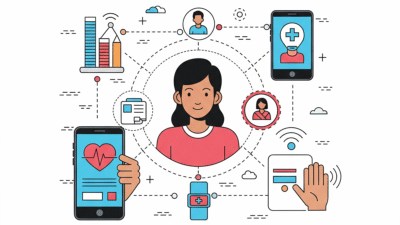The future of digital healthcare is rapidly unfolding, revolutionizing the way patients access and receive medical services. Technologies like telemedicine, wearable health devices, artificial intelligence, and electronic health records are streamlining healthcare delivery, improving diagnosis accuracy, and enhancing patient outcomes. These innovations are making healthcare more personalized, accessible, and efficient than ever before.
In 2025, digital health is not just a convenience; it is a necessity for modern medical systems worldwide. From remote monitoring and virtual consultations to AI-driven treatment planning, this blog explores how cutting-edge technology is transforming patient care and what it means for the future of global healthcare.
Table of Contents:
- Introduction: The digital shift in global healthcare
- Telehealth: Accessibility, convenience, and challenges
- Wearables and remote monitoring: Real-time health data and prevention
- AI in diagnostics and treatment planning
- EHRs and interoperability: Toward seamless care coordination
- Case studies of successful digital health adoption
- Challenges: Data privacy, digital divide, and regulatory hurdles
- Future trends and Conclusion
1. Introduction: The digital shift in global healthcare
- The global healthcare landscape is undergoing a dramatic transformation, fueled by rapid advancements in digital technology. From virtual consultations and wearable health monitors to AI-powered diagnostics and integrated electronic health records, digital tools are reshaping the way medical services are delivered, accessed, and experienced. The COVID-19 pandemic acted as a major catalyst, accelerating the adoption of telehealth and remote care across the world.
- Now in 2025, digital healthcare is not just an innovation that is becoming the backbone of modern medicine. This shift holds the potential to improve outcomes, enhance efficiency, and make quality care more accessible than ever before.
2. Telehealth: Accessibility, convenience, and challenges
- Telehealth has emerged as one of the most transformative aspects of digital healthcare, breaking down traditional barriers to medical access. In 2025, virtual consultations, remote diagnostics, and digital prescriptions have become routine for millions of patients worldwide.
- With just a smartphone or computer, individuals can connect with doctors, specialists, or mental health professionals from the comfort of their homes, eliminating long commutes, crowded waiting rooms, and scheduling difficulties.
- The accessibility of telehealth has been especially beneficial for rural populations, elderly patients, and individuals with limited mobility. It offers timely intervention, continuous monitoring, and faster follow-ups, all of which contribute to better health outcomes and lower healthcare costs. For healthcare providers, it opens up new avenues for reaching underserved communities and managing large patient populations more efficiently.
- However, telehealth is not without its challenges. A significant digital divide still exists, particularly in low-income and remote regions where internet access is unreliable or unaffordable. Moreover, not all medical conditions can be assessed remotely, and there is still hesitation among some practitioners and patients due to concerns about misdiagnosis, data security, and the loss of personal connection in virtual settings.
- Regulatory inconsistencies, reimbursement issues, and licensing restrictions across regions also hinder seamless telehealth integration. To fully realize the potential of telehealth, healthcare systems must address these challenges by investing in digital infrastructure, establishing clear standards, and ensuring equitable access for all.
3. Wearables and remote monitoring: Real-time health data and prevention
- Wearable health technologies and remote monitoring systems are at the forefront of preventive and personalized care. Devices such as smartwatches, fitness trackers, biosensors, and even smart clothing are no longer just lifestyle accessories; they are essential tools in modern healthcare.
- In 2025, these technologies are empowering individuals to take charge of their health while enabling providers to monitor patients continuously, detect early warning signs, and intervene before conditions escalate.
- Real-time data collection is revolutionizing preventive care. From tracking heart rate variability and blood pressure to monitoring glucose levels and sleep patterns, wearables provide an ongoing stream of actionable health information.
- Patients with chronic conditions like diabetes, hypertension, and heart disease benefit greatly from these tools, as doctors can make informed decisions based on consistent data rather than relying on periodic in-person visits.
- For clinicians, remote monitoring systems integrated with AI can flag anomalies, predict deterioration, and alert care teams in critical moments, saving lives and reducing hospital readmissions. These technologies also help optimize resource use by prioritizing care for high-risk patients while allowing others to self-manage their conditions with professional oversight.
- Despite their promise, wearables and remote monitoring devices face several challenges. Issues such as device accuracy, data privacy, and integration with existing electronic health record systems remain areas of concern.
- Moreover, adoption can be uneven across demographics, with older adults or economically disadvantaged groups sometimes lacking the technical skills or financial means to use such devices effectively.
- Looking ahead, as technology becomes more intuitive, affordable, and interoperable, wearables will likely become indispensable to preventive care, moving healthcare from reactive treatment to proactive health management on a global scale.
4. AI in diagnostics and treatment planning
- Artificial intelligence (AI) plays a transformative role in diagnostics and treatment planning, redefining how medical professionals assess, diagnose, and manage diseases. By Analyzing vast datasets with speed and precision far beyond human capabilities, AI enables earlier detection, more accurate diagnoses, and highly personalized care strategies all essential for improving outcomes and optimizing healthcare delivery in 2025.
- One of AI’s most impactful applications is in medical imaging analysis. Advanced algorithms can now scan and interpret X-rays, MRIs, and CT scans with remarkable accuracy, identifying abnormalities such as tumors, fractures, or lesions often missed by the human eye.
- In fields like oncology, radiology, and cardiology, AI-assisted diagnostics are not only increasing detection rates but also reducing time to diagnosis, critical for life-threatening conditions where every second counts.
- AI also plays a vital role in predictive analytics. By processing data from EHRs, lab results, wearable devices, and genomics, AI can assess a patient’s risk of developing specific conditions and recommend preventive interventions.
- For instance, algorithms can flag early signs of sepsis in hospitalized patients or predict the likelihood of readmission after surgery. This empowers healthcare teams to act proactively rather than reactively.
- In treatment planning, AI supports clinicians by generating evidence-based recommendations tailored to each patient’s unique medical history, genetic makeup, and real-time health data. In oncology, AI helps design personalized chemotherapy regimens; in mental health.
- It assists in monitoring mood patterns and suggesting therapy adjustments. These systems can also simulate treatment outcomes, allowing doctors to compare different approaches and select the most effective one.

5. EHRs and interoperability: Toward seamless care coordination
- Electronic Health Records (EHRs) have become the digital backbone of modern healthcare systems, centralizing patient information to support better clinical decision-making, reducing duplication, and enhancing care continuity.
- In 2025, the focus has shifted from simply digitizing medical records to achieving true interoperability where data flows freely, securely, and accurately across different healthcare providers, systems, and technologies.
- When properly implemented, EHRs offer a unified view of a patient’s medical history, including diagnoses, medications, allergies, lab results, imaging, and treatment plans. This comprehensive access allows healthcare providers to collaborate more effectively, avoid redundant testing, and tailor interventions to each patient’s needs.
- For patients, interoperable EHRs translate to smoother transitions between primary care, specialists, and emergency services, ensuring that every clinician has access to up-to-date, relevant information.
- Interoperability becomes especially critical in complex or chronic care scenarios. For instance, a diabetic patient managed by an endocrinologist, cardiologist, and primary care physician benefits immensely when all providers can access the same synchronized health data. It not only reduces errors but also enables better-coordinated, faster, and safer care.
- Governments and industry stakeholders are now pushing for standardized data protocols, such as HL7 FHIR (Fast Healthcare Interoperability Resources), to foster compatibility and innovation. API-based health data sharing and cloud infrastructure are also gaining traction, helping bridge gaps between hospitals, insurers, labs, pharmacies, and even patients themselves via health apps and personal portals.
6. Case studies of successful digital health adoption
Real-world case studies highlight how digital health technologies are not just theoretical innovations but practical tools driving measurable improvements in patient care, operational efficiency, and healthcare outcomes. Across the globe, healthcare systems and organizations are successfully integrating telehealth, AI, wearables, and interoperable systems, proving the transformative power of digital health when applied effectively.
Kaiser Permanente (United States): Telehealth at Scale
- Kaiser Permanente, one of the largest integrated healthcare systems in the U.S., has been a pioneer in telehealth.
- By 2025, over 60% of outpatient visits are conducted remotely, with seamless integration into their EHR system.
- This has reduced wait times, improved chronic care management, and led to high patient satisfaction.
- Their use of video consultations and secure messaging platforms has made healthcare more accessible and cost-effective.
Apollo Hospitals (India): AI-Powered Triage and Diagnostics
- Apollo Hospitals, a leading private healthcare provider in India, has adopted AI tools for diagnostic support and clinical decision-making. Through collaboration with global tech firms, they use AI-based platforms for predicting cardiovascular risk, detecting diabetic retinopathy, and optimizing treatment pathways.
- Their AI triage system, used in emergency rooms, prioritizes patients more accurately and efficiently, leading to faster treatment and improved survival rates in critical cases.
NHS (United Kingdom): National Digital Health Strategy
- The UK’s National Health Service (NHS) has embraced digital transformation with its NHS App, which allows users to book appointments, order prescriptions, view medical records, and access COVID-19 services.
- Interoperability across GP practices, hospitals, And pharmacies Pharmacies has improved dramatically. Digital consultations increased from 10% pre-2020 to over 70% by 2025.
- The NHS also leverages data analytics for population health management, targeting preventive interventions more effectively.
Clalit Health Services (Israel): Predictive Analytics for Preventive Care
- Clalit, Israel’s largest health maintenance organization, uses advanced predictive analytics powered by AI to identify patients at high risk for hospitalization, diabetes complications, and other chronic conditions.
- By combining EHRs, lab results, and socioeconomic data, they intervene early with personalized care plans and remote monitoring. This proactive approach has significantly reduced emergency visits and improved long-term patient outcomes.
Babylon Health (Global): AI and Digital-First Healthcare
- Babylon Health offers digital-first healthcare through AI-driven chatbots and remote consultation services.
- Operating in multiple countries, including Rwanda, the UK, and Canada, Babylon’s platform uses symptom checkers, virtual appointments, and continuous monitoring to provide 24/7 access to care.
- In underserved areas, Babylon has helped bridge the healthcare access gap using mobile-first solutions supported by minimal infrastructure.
7. Challenges: Data privacy, digital divide, and regulatory hurdles
- While digital health technologies offer significant promise, their widespread adoption is hindered by a complex set of challenges.
- As the healthcare sector embraces digital transformation, stakeholders must confront issues related to data privacy, the digital divide, and regulatory complexity, all of which can impede progress if left unaddressed.
Data Privacy and Security
- Patient health data is among the most sensitive forms of personal information. With digital health solutions collecting and transmitting vast amounts of data from EHRs to wearable devices, the risks associated with cybersecurity breaches, unauthorized access, and data misuse are increasingly significant. High-profile healthcare data breaches in recent years have exposed millions of records, eroding public trust.
- Ensuring robust encryption, access controls, and compliance with data protection laws like HIPAA (U.S.), GDPR (EU), and emerging frameworks worldwide is essential.
- However, the rapid evolution of technologies often outpaces the development of security standards, making data governance a moving target. Additionally, questions around data ownership, consent, and third-party data sharing remain unresolved in many jurisdictions.
The Digital Divide
- Digital health assumes access to the internet, smart devices, and a basic level of digital literacy resources not equitably distributed across all populations. Rural communities, elderly individuals, low-income groups, and people with disabilities often lack reliable internet, up-to-date devices, or the skills needed to navigate digital health platforms.
- This digital divide risks creating a two-tiered healthcare system where the benefits of digital innovation are unevenly experienced. Without intentional efforts to expand digital infrastructure and provide inclusive education, large segments of the population could be left behind in the transition to tech-enabled healthcare.
Regulatory and Legal Hurdles
- Healthcare is a heavily regulated industry, and integrating new digital tools often clashes with existing legal frameworks. Cross-border telehealth, AI-assisted diagnoses, and decentralized data systems all raise complex questions about licensing, reimbursement, and patient rights.
- In many countries, telemedicine laws remain fragmented, requiring providers to navigate varying licensure rules across regions. Reimbursement for digital services is often unclear or inconsistent, discouraging adoption. Moreover, AI-driven tools challenge traditional regulatory models, as existing approval processes may not fully account for adaptive algorithms that evolve over time.
- Governments and regulatory bodies are working to catch up, with some positive movement toward interoperability standards, digital health certifications, and sandbox environments for innovation testing. However, progress is uneven, and many startups and providers remain constrained by outdated or ambiguous policies.
8. Future trends and Conclusion
As digital healthcare continues to evolve, several emerging trends are poised to further reshape the industry in the years ahead. These innovations, driven by technological advancement, patient demand, and policy reform, will push healthcare systems toward smarter, more integrated, and more equitable care models.
Future Trends in Digital Healthcare:
- Personalized and Precision Medicine – AI and genomics are converging to enable highly tailored treatments based on individual genetic profiles, lifestyle data, and environmental factors. This trend will lead to more effective therapies and reduced trial-and-error in treatment plans.
- Virtual and Augmented Reality (VR/AR) – VR and AR technologies are increasingly used for medical training, patient education, pain management, and even physical therapy—making care delivery more immersive, engaging, and effective.
- Decentralized Clinical Trials – Remote monitoring tools, mobile apps, and digital platforms are enabling decentralized trials that reduce patient burden, improve diversity in clinical studies, and speed up drug development timelines.
- AI-Driven Mental Health Support – Mental health platforms powered by natural language processing and AI are providing 24/7 support, early intervention, and personalized therapy plans, helping address global mental health challenges at scale.
- Blockchain for Health Data Security – Blockchain is being explored for secure, transparent health data sharing, ensuring data integrity, access control, and interoperability across systems and borders.
- Global Health Equity Through Tech – Digital health initiatives are expanding in low-resource settings, bringing vital care to remote communities through mobile clinics, AI diagnostics, and telemedicine—bridging long-standing gaps in access.
9. Conclusion
- The digital transformation of healthcare is no longer a distant vision is a present reality that continues to accelerate in 2025.
- From AI-powered diagnostics and remote monitoring to interoperable EHRs and telemedicine, digital technologies are reshaping the core of how healthcare is delivered and experienced around the world.
- These innovations promise to enhance patient outcomes, improve system efficiency, and expand access to care like never before.
- However, to fully harness these benefits, it is crucial to address persistent challenges is particularly around data privacy, equitable access, and regulatory clarity.
- A future where digital health works for everyone requires collaboration across governments, providers, technologists, and patients.
- As we look ahead, the path forward lies in embracing innovation responsibly and inclusively. Digital healthcare is not just about new tools is about redefining care to be more intelligent, proactive, connected, and human-centered.





asd